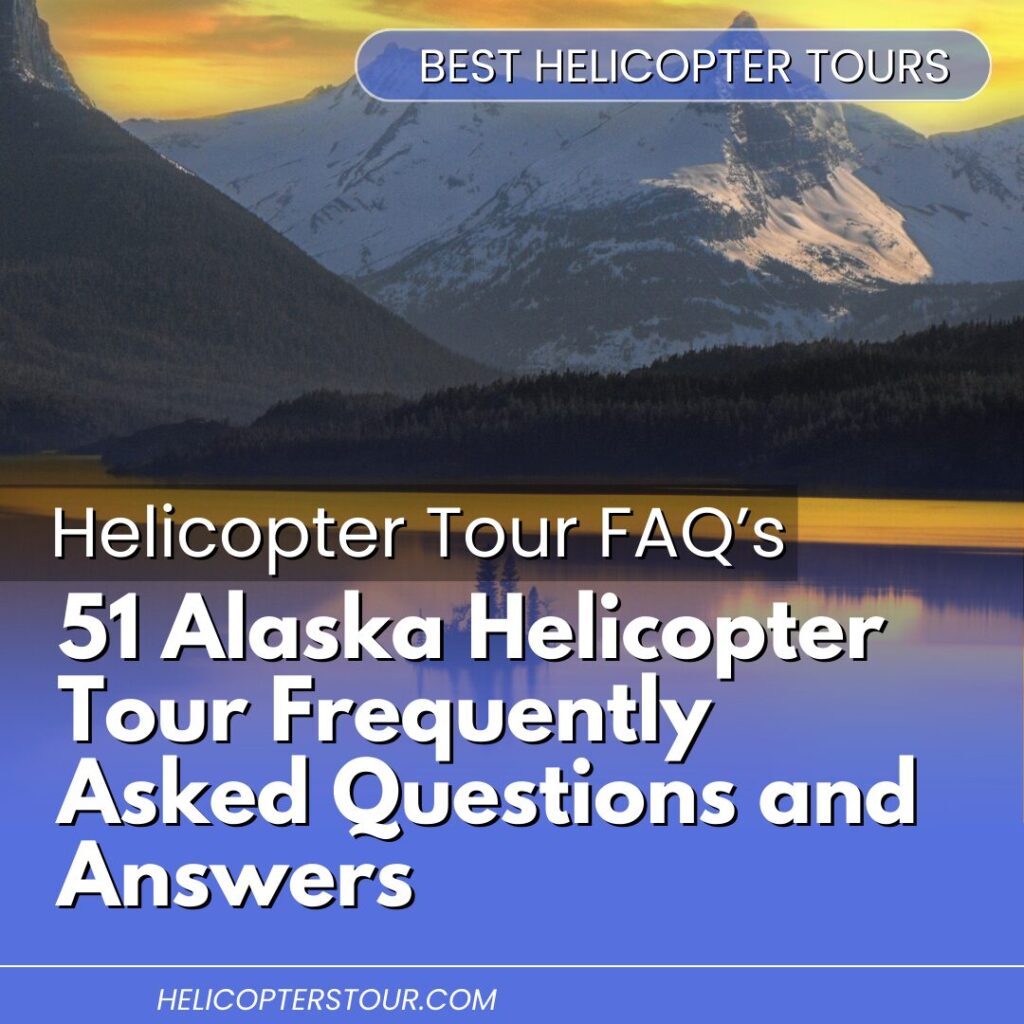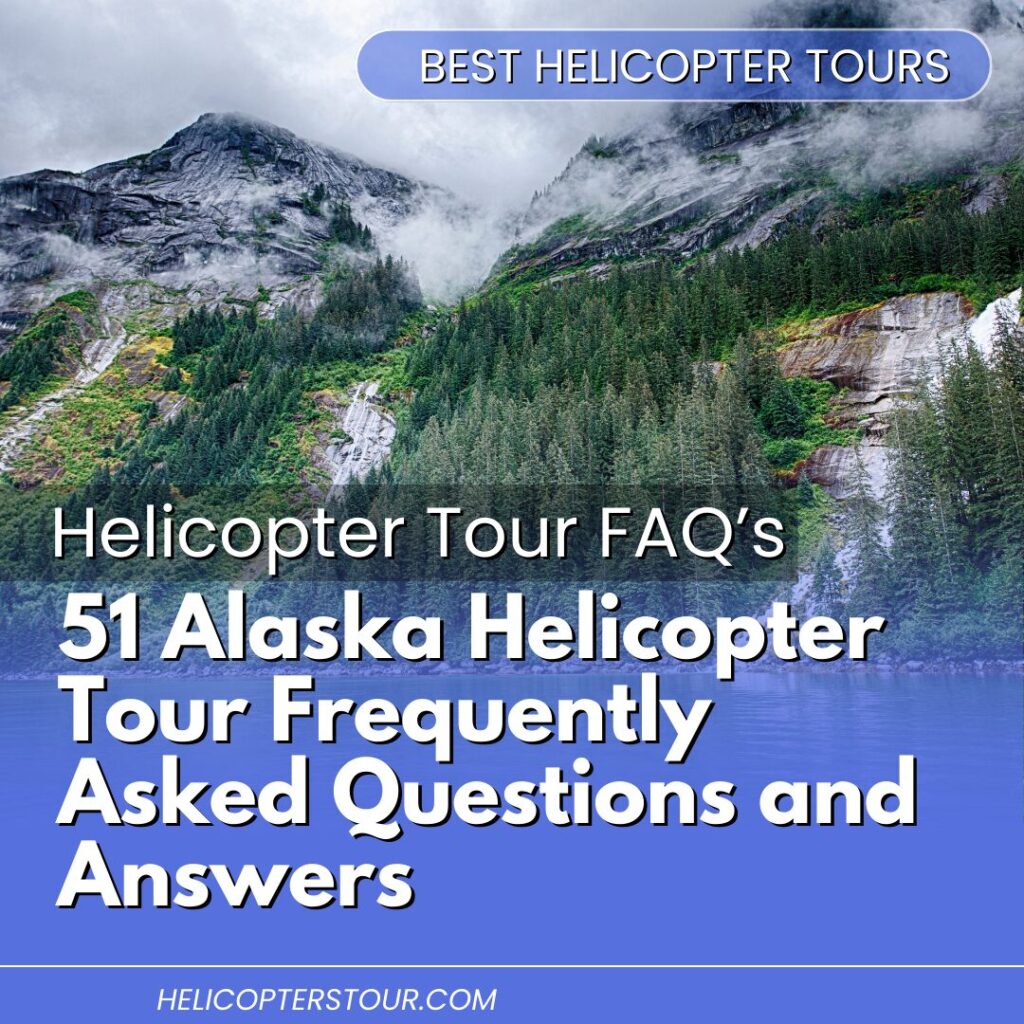Of all the places I’ve had the chance to fly, Alaska is in a league of its own. The word ‘epic’ gets thrown around a lot, but here, it actually fits. The scale of the mountains, the size of the glaciers, the sheer wildness of it all—it’s something you can’t fully appreciate until you see it from above. An Alaska Helicopter Tour isn’t just about sightseeing; it’s about accessing a world that is completely out of reach, a world of ancient ice and raw, untouched nature.
The experience here is fundamentally different. It’s not just about what you see, but what you get to do. I want to walk you through the signature Alaskan adventures and the best places to launch your trip from.
The Ultimate Alaskan Experience: Glacier Landings & Dog Sledding
Two things set an Alaska Helicopter Tour apart from any other in the world:
- Glacier Landings: This is the absolute must-do. You don’t just fly over the glaciers; you land on them. The feeling of stepping out of the helicopter onto ice that is hundreds of feet thick and thousands of years old is unreal. You’re surrounded by towering, snow-covered peaks in a world of silence and brilliant blue and white ice. It’s a humbling and unforgettable experience.
- Helicopter Glacier Dog Sledding: This sounds like something out of a movie, but it’s a real and incredible adventure. You fly up to a remote dog sled camp located high on a glacier. There, you meet the mushers and their teams of incredible sled dogs and then go for a ride across the snow. Doing this in the middle of summer is a uniquely Alaskan experience.

Choosing Your Base: Main Departure Hubs
Where you take your tour from will define the scenery you see. Here are the main hubs:
- Anchorage / Girdwood: This is the gateway to the massive glaciers of the Chugach Mountains, like the Knik Glacier. Girdwood is a bit closer, offering quick access to stunning ice formations.
- Seward: If you want to see the intersection of ice and ocean, this is the spot. Tours here focus on Kenai Fjords National Park, flying over the immense Harding Icefield and tidewater glaciers that calve directly into the sea.
- Juneau: The capital city is the departure point for exploring the vast Juneau Icefield, the source of the famous Mendenhall Glacier and dozens of others.
- Denali National Park Area (Talkeetna/Healy): For the ultimate mountain flight, this is it. Tours fly into the Alaska Range, getting you up close to the staggering peaks and glaciers surrounding Denali, North America’s tallest mountain.
51 Alaska Helicopter Tour FAQ’s
1. Question: What makes an Alaska Helicopter Tour unique compared to other locations?
Answer: An Alaska Helicopter Tour is defined by its epic scale and unique experiences. The primary draw is the ability to fly over and land on massive glaciers, witness stunning ice formations, see remote mountain peaks, and potentially view iconic Alaskan wildlife in its natural, inaccessible habitat.
2. Question: Can you actually land on a glacier?
Answer: Yes! Glacier landings are the signature feature of many Alaska Helicopter Tours. Pilots are highly skilled at landing in designated, safe zones on the glaciers, allowing passengers to get out, walk on ancient ice, and experience the incredible landscape up close.
3. Question: What is a glacier landing experience like?
Answer: It’s a surreal and breathtaking experience. After a scenic flight, the helicopter will set down gently on the ice. You’ll step out into a vast, quiet world of white and blue ice, surrounded by towering mountain peaks. You can walk around, take photos, and sometimes even drink pure glacial water from a melt pool.
4. Question: What should I wear on an Alaska Helicopter Tour with a glacier landing?
Answer: Dressing in layers is crucial. Wear a warm base layer, a fleece or mid-layer, and a waterproof/windproof outer jacket. Warm pants (not jeans), wool socks, and waterproof boots are highly recommended. Most tour operators provide glacier overboots, but you should still wear sturdy, closed-toe shoes. Don’t forget sunglasses (the glare off the ice is intense), a warm hat, and gloves.
5. Question: What wildlife might I see from the helicopter?
Answer: Wildlife sightings are a thrilling possibility. Depending on the location and season, you might spot bears (grizzly or black), moose, Dall sheep on mountain ridges, mountain goats, and sometimes even whales or other marine life if your tour is coastal. However, sightings are never guaranteed.
6. Question: What is helicopter glacier dog sledding?
Answer: This is a truly unique Alaskan adventure. You take an Alaska Helicopter Tour up to a dog sled camp located on a glacier. There, you’ll meet professional mushers and their sled dogs and take an exhilarating ride across the snow-covered glacier, pulled by an energetic team.
7. Question: Where do most Alaska Helicopter Tours depart from?
Answer: Major departure hubs include Anchorage, Girdwood (near Alyeska Resort), Seward (Kenai Fjords), Juneau (Mendenhall Glacier), Talkeetna and Denali National Park area, and Skagway.
8. Question: What’s the difference between a tour from Anchorage vs. Girdwood?
Answer: Tours from Anchorage often fly into the Chugach Mountains, exploring the Knik or Colony glaciers. Girdwood, being closer to the mountains, offers quicker access to glaciers like the George, Colony, and Lake George Glacier, often called the ‘Grand Canyon of Glaciers’.
9. Question: What will I see on a helicopter tour from Seward?
Answer: Seward tours focus on the magnificent Kenai Fjords National Park. You’ll fly over the massive Harding Icefield, see tidewater glaciers that calve into the ocean, and look for marine wildlife like whales, sea otters, and seals in the fjords below.
10. Question: What are helicopter tours near Denali National Park like?
Answer: These tours offer unparalleled views of the Alaska Range. You’ll fly alongside the immense peaks, explore the glaciers flowing from North America’s tallest mountain, Denali, and witness the vast, wild tundra of the park’s landscape.
11. Question: Are tours from Juneau focused on the Mendenhall Glacier?
Answer: Yes, but they show you much more. A Juneau Alaska Helicopter Tour will fly over the Mendenhall Glacier, but also the vast Juneau Icefield it flows from, revealing a stunning world of icefalls, crevasses, and other glaciers that are completely hidden from the ground.
12. Question: When is the best time of year for an Alaska Helicopter Tour?
Answer: The main season runs from May through September when the weather is best and daylight hours are long. Summer months (June, July, August) offer the warmest temperatures, but spring and fall can provide beautiful scenery and fewer crowds.
13. Question: How long are the tours?
Answer: Tour durations vary. A simple scenic flight might be 30 minutes. A standard glacier landing tour is often 60-90 minutes (including about 15-30 minutes on the ice). Helicopter dog sledding or heli-hiking tours can last 2-3 hours.
14. Question: Is it safe to land on a glacier?
Answer: Absolutely. Tour operators have years of experience and use established, pre-approved landing zones that are known to be stable and safe. Pilots are highly trained in mountain and glacier flying techniques.
15. Question: What is a ‘crevasse’ and will I see one?
Answer: A crevasse is a deep crack in a glacier. You will see countless crevasses from the air, which often glow with a spectacular deep blue color. During your landing, you will be in a safe zone far from any open crevasses.
16. Question: What about weather cancellations?
Answer: Alaska’s weather is famously unpredictable. Pilots will not fly if conditions (like heavy rain, fog, or high winds) are unsafe. It’s wise to book your tour for the beginning of your trip to allow flexibility for rescheduling. If the company cancels, you’ll get a full refund.
17. Question: How far in advance should I book my Alaska Helicopter Tour?
Answer: Book as far in advance as possible, especially for popular tours like glacier dog sledding or for trips during the peak months of July and August. These are bucket-list experiences with limited capacity and they sell out.
18. Question: Are there weight restrictions on these tours?
Answer: Yes, all tours have weight restrictions for aircraft safety and balance. These policies vary by company, but be prepared to provide your weight when booking. Passengers over a certain limit (e.g., 250 lbs) may need to purchase an additional seat.
19. Question: Is it very cold on the glacier?
Answer: It will be colder than at sea level, but on a sunny summer day, it can be surprisingly pleasant. However, the weather can change instantly. Always dress in the warm layers recommended by the tour company, as it’s better to have too many than not enough.
20. Question: Do I need special boots for the glacier?
Answer: Most operators provide overboots with traction that fit over your regular shoes. You should still wear sturdy, comfortable, closed-toe footwear like hiking boots or trail shoes. Avoid sandals, heels, or slip-on shoes.
21. Question: Can children go on an Alaska Helicopter Tour?
Answer: Yes, most tours are family-friendly. Children under two can often fly on a parent’s lap. All children will be provided with a headset. It’s a fantastic educational and awe-inspiring experience for kids.
22. Question: What is a ‘tidewater’ glacier?
Answer: A tidewater glacier is a glacier that flows all the way down to the ocean. You are most likely to see these on tours from Seward, Whittier, or Juneau. Witnessing a tidewater glacier is a powerful sight.
23. Question: What is ‘calving’?
Answer: Calving is when large chunks of ice break off the front of a tidewater glacier and crash into the ocean. While it’s impossible to guarantee you’ll see it, your pilot will often linger near active glaciers in the hopes of witnessing this spectacular natural event.
24. Question: Can I bring a backpack or bag with me?
Answer: Generally, no. For safety and weight reasons, large bags and backpacks are not allowed in the helicopter. Secure storage is provided at the heliport. You can typically bring your camera and phone.
25. Question: What kind of helicopters are used?
Answer: Operators in Alaska use a variety of reliable and safe helicopters. Common models include the Airbus A-Star (AS350), which is known for its excellent visibility, and the Robinson R44 for smaller groups.
26. Question: Will the pilot provide commentary?
Answer: Absolutely. All passengers wear two-way headsets that allow you to hear the pilot’s expert narration about the glaciers, geology, and history of the area you are flying over. You can also ask questions.
27. Question: Is an Alaska Helicopter Tour worth the cost?
Answer: Without a doubt. It is consistently rated as a top highlight of any Alaska vacation. The tour provides access to landscapes and experiences that are truly impossible to reach any other way, creating memories that will last a lifetime.
28. Question: How experienced are the pilots?
Answer: Alaskan pilots are among the most skilled in the world. They have extensive experience flying in mountainous terrain and challenging weather conditions and undergo rigorous, continuous training.
29. Question: What is heli-hiking?
Answer: Heli-hiking combines an Alaska Helicopter Tour with a guided hike. The helicopter drops you and a guide off in a remote, stunning location—like an alpine meadow or a glacier moraine—for a hike through pristine, untouched wilderness.
30. Question: Can I drink the water on the glacier?
Answer: Often, yes! The water in glacial melt pools is some of the purest, freshest water on the planet. Your pilot or guide will show you a safe place to get a drink. It’s a memorable part of the experience.
31. Question: Do I need to be in good physical shape for a glacier landing?
Answer: No. The landing zones are generally flat and easy to walk on (with the provided overboots). You only need to be able to walk a short distance from the helicopter. Heli-hiking tours, however, do require a moderate level of fitness.
32. Question: Why is the glacial ice so blue?
Answer: Glacial ice is incredibly dense. Over centuries, the weight of the ice squeezes out all the air bubbles. This dense ice absorbs every other color in the spectrum and reflects blue, giving it that stunning, deep blue hue, especially in crevasses and ice caves.
33. Question: Will I get motion sickness?
Answer: Helicopter flights are generally very smooth. If you are extremely prone to motion sickness, taking a non-drowsy remedy beforehand is a good precaution. However, most people are so captivated by the views they don’t experience any discomfort.
34. Question: Are tours wheelchair accessible?
Answer: This depends on the company and the aircraft. Many operators can accommodate guests with limited mobility and use collapsible wheelchairs. It is essential to contact the tour operator directly in advance to discuss your specific needs.
35. Question: How close do you get to wildlife?
Answer: Pilots adhere to strict regulations to avoid disturbing wildlife. They will maintain a safe and respectful distance while still providing excellent viewing and photo opportunities. The goal is to observe the animals in their natural state without causing stress.
36. Question: What is the difference between a helicopter tour and a fixed-wing flightseeing tour?
Answer: A helicopter has the unique ability to hover, fly slower, and land in remote, rugged locations like on top of a glacier. A fixed-wing plane can cover more distance and is often used for tours to places like Denali, but it cannot land on a glacier.
37. Question: Do I get to choose my seat?
Answer: No, seats are assigned by the pilot based on the weight of all passengers to ensure the aircraft is balanced for safety. Every seat on a modern tour helicopter is designed to provide excellent views.
38. Question: Is there a restroom at the heliport or on the helicopter?
Answer: There are restrooms at the heliport, and you should use them before your flight. There are no restrooms on the helicopter.
39. Question: What happens if I’m late for my tour?
Answer: Helicopter tours run on a tight schedule. If you are late, you may miss your flight, and you will likely not be eligible for a refund. Always allow extra time to get to the heliport.
40. Question: Are private tours available?
Answer: Yes, all operators offer private charters. A private Alaska Helicopter Tour is perfect for a special occasion, professional photography, or a family that wants a fully customized experience.
41. Question: What is an ‘icefall’?
Answer: An icefall is a portion of a glacier characterized by rapid flow and a chaotic surface of crevasses and ice pinnacles. It’s essentially a frozen, slow-motion waterfall of ice. You will see many spectacular icefalls on your tour.
42. Question: How much time do we get on the glacier?
Answer: The time on the glacier for a standard landing tour is typically 15 to 30 minutes. This provides plenty of time to walk around, take photos, and soak in the incredible environment.
43. Question: Are the dog sledding camps on the glaciers year-round?
Answer: The dog sledding camps are seasonal and operate only during the summer months (typically May to September). The high elevation and snow cover on the glacier create perfect summer training conditions for the sled dogs.
44. Question: Should I bring a camera?
Answer: Absolutely! An Alaska Helicopter Tour is a photographer’s dream. Bring your camera and phone, and make sure your batteries are fully charged and you have plenty of memory space. You will take more photos than you think.
45. Question: Will I see the Northern Lights on a helicopter tour?
Answer: No. Nearly all scenic helicopter tours operate during daylight hours for safety. Northern Lights viewing is a nighttime activity, best done from the ground during the late fall, winter, and early spring.
46. Question: What is the Harding Icefield?
Answer: The Harding Icefield is an expansive ice sheet over 700 square miles in size located in the Kenai Mountains. It is the source for nearly 40 glaciers. An Alaska Helicopter Tour from Seward gives you an incredible view of this immense river of ice.
47. Question: Can I propose on an Alaska Helicopter Tour?
Answer: Yes! A glacier landing provides an epic and unforgettable setting for a marriage proposal. Many couples get engaged this way. It’s best to book a private tour and coordinate with the operator beforehand to make it a special surprise.
48. Question: Is tipping the pilot expected?
Answer: Tipping is not required but is greatly appreciated. If you had a fantastic and safe experience, a tip is a wonderful way to show your gratitude to your pilot for their skill and knowledge.
49. Question: How different is the scenery in May vs. September?
Answer: In May, you’ll see more snow on the mountains, and the landscape will be just waking up from winter. In September, you may be treated to stunning fall colors in the valleys, a beautiful contrast to the blue and white of the glaciers.
50. Question: Can I get a video of my flight?
Answer: Some companies have camera systems that record your flight, and you can purchase the video as a souvenir. If not, you are always welcome to record your own video during the tour.
51. Question: What is the single best reason to take an Alaska Helicopter Tour?
Answer: Perspective. An Alaska Helicopter Tour gives you a true understanding of the immense scale and wildness of the Last Frontier. Seeing the massive glaciers, endless mountain ranges, and pristine wilderness from above is a humbling and life-changing experience.

An Alaska helicopter tour is so much more than a scenic flight – it’s an adventure that puts you directly into a landscape that most people will only ever see in pictures. It’s the feeling of your boots crunching on ancient ice, the sound of sled dogs ready to run, and the humbling sight of a river of ice flowing between mountains.
Yes, it’s a big-ticket item, but it delivers an experience that is truly priceless. It’s the one thing that will give you the truest sense of Alaska’s wild heart.
We’ve sorted through all the options to help you find the perfect trip. When you’re ready to plan your adventure, head over to the site and check out our guide to the Best Alaska Helicopter Tours and reviews.
Best Helicopter Tours by Destination
Explore our expert picks for New York, Grand Canyon, Alaska, Iceland, Hawaii, and Cape Town. Compare routes, flight times, doors-off options, prices, and insider tips, then book the tour that fits your trip.
Top 14 Best Kauai Helicopter Tours for Breathtaking Island Views
Top 20 Best Oahu Helicopter Tours for The Best Views of the Island
Top 10 Hilo and Kona, Hawaii – Best Big Island Helicopter Tours
Discover Maui from Above: 15 Best Maui Helicopter Tours for Travelers
Top 25 Best New York Helicopter Tours for Breathtaking City Views
Top 20 Best Cape Town Helicopter Tours for Stunning Views.
Top 18 Best Alaska Helicopter Tours for Epic Glacier Landings
Top 5 Best Las Vegas Strip Helicopter Tours of 2025 – The Best Skyline Views
Common Helicopter Tour FAQ’s
50 Helicopter Tour Common Frequently Asked Questions and Answers





